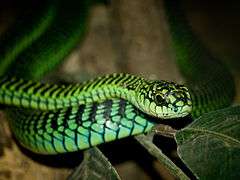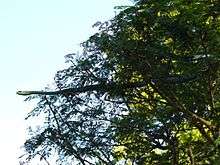Boomslang
The boomslang (/ˈboʊmslɑːŋ/, /ˈbɔːmsləŋ/, or /ˈbuːmslæŋ/; Dispholidus typus) is a large, highly venomous snake in the family Colubridae.[2]
| Boomslang | |
|---|---|
 | |
| Male at campsite in the Ngorongoro Conservation Area | |
| Scientific classification | |
| Kingdom: | Animalia |
| Phylum: | Chordata |
| Class: | Reptilia |
| Order: | Squamata |
| Suborder: | Serpentes |
| Family: | Colubridae |
| Genus: | Dispholidus Duvernoy, 1832 |
| Species: | D. typus |
| Binomial name | |
| Dispholidus typus (A. Smith, 1828) | |
| Synonyms[1] | |
| |
Taxonomy and etymology
Dispholidus typus is the only species in its genus, although several species and subspecies have been described in the past. Its common name means "tree snake" in Afrikaans and Dutch[3] – boom meaning "tree" (a cognate of "beam", like German Baum, "tree"), and slang meaning "snake" (cf. German Schlange, same meaning). In Afrikaans, the name is pronounced [ˈbuəmslaŋ]. The boomslang is thought to be closely related to members of the genera Thelotornis, Thrasops, Rhamnophis, and Xyelodontophis, with which it forms the taxonomic tribe Dispholidini.[4]
Subspecies
Three subspecies are recognized, including the nominotypical subspecies.[5]
- D. t. kivuensis Laurent, 1955
- D. t. punctatus Laurent, 1955
- D. t. typus (A. Smith, 1828)
The trinomial authority in parentheses for D. t. typus indicates that the subspecies was originally described in a genus other than Dispholidus.
Description
.jpg)
The average adult boomslang is 100–160 centimetres (3.3–5.2 ft) in total length. Some exceed 183 centimetres (6.00 ft). The eyes are exceptionally large, and the head has a characteristic egg-like shape. Coloration is very variable. Males are light green with black or blue scale edges, but adult females may be brown.[6]
Weight varies from 175 to 510 g (0.386 to 1.124 lb), with an average weight of 299.4 g (0.660 lb).[7]
In this species, the head is distinct from the neck and the canthus rostralis is distinct. The pupil of the very large eye is round. The boomslang has excellent eyesight and often moves its head from side to side to get a better view of objects directly in front. The maxillary teeth are small anteriorly, seven or eight in number, followed by three very large, grooved fangs situated below each eye. The mandibular teeth are subequal. The body is slightly compressed. The dorsal scales are very narrow, oblique, strongly keeled, with apical pits, arranged in 19 or 21 rows. The tail is long, and the subcaudals are paired. Ventrals are 164–201; the anal plate is divided; and the subcaudals are 91–131.[1]
Geographic range
The boomslang is native and restricted to sub-Saharan Africa.
Reproduction
The boomslang is oviparous, and an adult female can produce up to 30 eggs, which are deposited in a hollow tree trunk or rotting log. The eggs have a relatively long (3 months on average) incubation period. Male hatchlings are grey with blue speckles, and female hatchlings are pale brown. They attain their adult coloration after several years. Hatchlings are about 20 cm (7.9 in) in length and pose no threat to humans, but are dangerously venomous by the time they reach a length around 45 cm (18 in) and a girth as thick as an adult's smallest finger.
Behavior and diet

D. typus is diurnal and almost exclusively arboreal. It is reclusive, and flees from anything too large to eat. Its diet includes chameleons and other arboreal lizards,[2] frogs, and occasionally small mammals, birds, and eggs from nesting birds,[2] all of which it swallows whole. Boomslangs will also feed on other snakes, including cannibalizing members of their own species. [8] During cool weather, boomslangs brumate for moderate periods, often curling up inside the enclosed nest of a weaverbird.
Venom
Many venomous members of the family Colubridae are harmless to humans because of small venom glands and inefficient fangs. However, the boomslang is a notable exception in that it has a highly potent venom, which it delivers through large fangs located in the back of the jaw.[2] The boomslang is able to open its jaws up to 170° when biting.[9] The venom of the boomslang is primarily a hemotoxin; it disables the coagulation process and the victim may die as a result of internal and external bleeding. The venom has been observed to cause hemorrhage into tissues such as muscle and brain.[2][10] Other signs and symptoms include headache, nausea, sleepiness, and mental disorders.
Because boomslang venom is slow-acting, symptoms may not become apparent until many hours after the bite. Although the absence of symptoms provides sufficient time for procuring antivenom, it can also provide victims with false reassurance, leading to their underestimating the seriousness of the bite. Snakes of any species may sometimes fail to inject venom when they bite (a so-called "dry bite"), so after a few hours without any noticeable effects, victims of boomslang bites may wrongly believe that their injury is not serious or life-threatening. The pathophysiological mechanisms of the venom are different with every snake, resulting in different clinical manifestations with every patient.[11]
An adult boomslang has 1.6 to 8 mg of venom.[12] Its median lethal dose (LD50) in mice is 0.1 mg/kg (intravenously).[13] 0.071 mg/kg(IV) has also been reported.[14]
In 1957, herpetologist Karl Schmidt died after being bitten by a juvenile boomslang, which he doubted could produce a fatal dose.[15][16] He made notes on the symptoms he experienced almost to the end.[17][18] D. S. Chapman reported eight serious envenomations by boomslangs between 1919 and 1962, two of which were fatal.[19]
Boomslang monovalent antivenom was developed during the 1940s. The South African Vaccine Producers manufactures a monovalent antivenom for use in boomslang envenomations.[20] Treatment of bites may also require complete blood transfusions, especially after 24 to 48 hours without antivenom.
The boomslang is a timid snake, and bites generally occur only when people attempt to handle, catch, or kill the animal. When confronted and cornered, it inflates its neck and assumes an "S"-shaped striking pose. The above data suggest that the boomslang is unlikely to be a significant source of human fatalities throughout its geographic range.
Gallery
 A male boomslang
A male boomslang
References
- Boulenger GA (1896). Catalogue of the Snakes in the British Museum (Natural History). Volume III., Containing the Colubridæ (Opisthoglyphæ and Proteroglyphæ) ... London: Trustees of the British Museum (Natural History). (Taylor and Francis, printers). xiv + 727 pp. + Plates I-XXV. (Genus Dispholidus, pp. 186-187; species Dispholidus typus, pp. 187–189, Figure 14).
- Encyclopædia Britannica. Encyclopædia Britannica, Inc. 2007.
- Oxford English Dictionary. Oxford, England: Oxford University Press. 1989.
- Broadley, Donald; Wallach, Van (November 2002). "Review of the Dispholidini, with the description of a new genus and species from Tanzania (Serpentes, Colubridae)". Bull. Br. Mus. (Nat. Hist.) Zool. 68 (2): 57–74. doi:10.1017/S0968047002000079.
- Species Dispholidus typus at The Reptile Database . www.reptile-database.org.
- http://www.tigerhomes.org/animal/boomslang-snake.cfm%5B%5D
- Grassy E MD (June 22, 1940). "Studies on the Venom of the Boomslang". South African Medical Journal.
- https://animaldiversity.org/accounts/Dispholidus_typus/
- Marais, Johan (2004). A Complete Guide to the Snakes of Southern Africa. Second Edition. Struik.
- Kamiguti AS, Theakston RD, Sherman N, Fox JW (November 2000). "Mass spectrophotometric evidence for P-III/P-IV metalloproteinases in the venom of the boomslang (Dispholidus typus)". Toxicon. 38 (11): 1613–1620. doi:10.1016/S0041-0101(00)00089-1. PMID 10775761.
- Article Title Figure 2f from: Irimia R, Gottschling M (2016) Taxonomic revision of Rochefortia Sw. (Ehretiaceae, Boraginales). Biodiversity Data Journal 4: e7720. https://doi.org/10.3897/BDJ.4.e7720
- "LD50 for various snakes". seanthomas.net. Retrieved 2017-11-14.
- Mackessy, Stephen P. (2002). Biochemistry and Pharmacology of Colubrid Snake Venoms. J. Toxicol. – Toxin Reviews 21 (1&2): 52. online PDF Archived 2010-06-02 at the Wayback Machine
- http://www.scielo.br/scielo.php?script=sci_arttext&pid=S0104-79301996000100007
- "Diary of A Snakebite Death".
- "The Boomslang Snake Of Africa". www.reptilesmagazine.com. Retrieved 2017-11-14.
- Pope, Clifford H (1958). "Fatal Bite of Captive African Rear-Fanged Snake (Dispholidus)". Copeia. 1958 (4): 280–282. doi:10.2307/1439959. JSTOR 1439959.
- Smith, Charles H. "Chrono-Biographical Sketch: Karl P. Schmidt". Some Biogeographers, Evolutionists and Ecologists. Retrieved 9 September 2014.
- Bücherl W, Buckley E, Deulofeu V (editors) (1968). Venomous Animals and Their Venoms, Volume I: Venomous Vertebrates. Academic Press. p. 484.
- "About Us – South African Vaccine Producers (SAVP)". Retrieved 3 November 2015.
Further reading
- Branch, Bill (2004). Field Guide to Snakes and other Reptiles of Southern Africa. Third Revised edition, Second impression. Sanibel Island, Florida: Ralph Curtis Books. 399 pp. ISBN 0-88359-042-5. (Dispholidus typus, pp. 99–100 + Plate 31).
- Goin CJ, Goin OB, Zug GR (1978). Introduction to Herpetology, Third Edition. San Francisco: W.H. Freeman. xi + 378 pp. ISBN 0-7167-0020-4. (Dispholidus typus, pp. 322, 324).
- Laurent RF (1955). "Diagnoses preliminaires des quelques Serpents venimeux ". Revue de zoologie et de botanique africaines 51: 127-139. (Dispholidus typus kivuensis, new subspecies; D. t. punctatus, new subspecies). (in French).
- Smith A (1828). "Descriptions of New or Imperfectly Known Objects of the Animal Kingdom, Found in the South of Africa". South African Commercial Advertiser 3 (144): 2. (Bucephalus typus, new species).
External links
| Wikimedia Commons has media related to Boomslang. |
